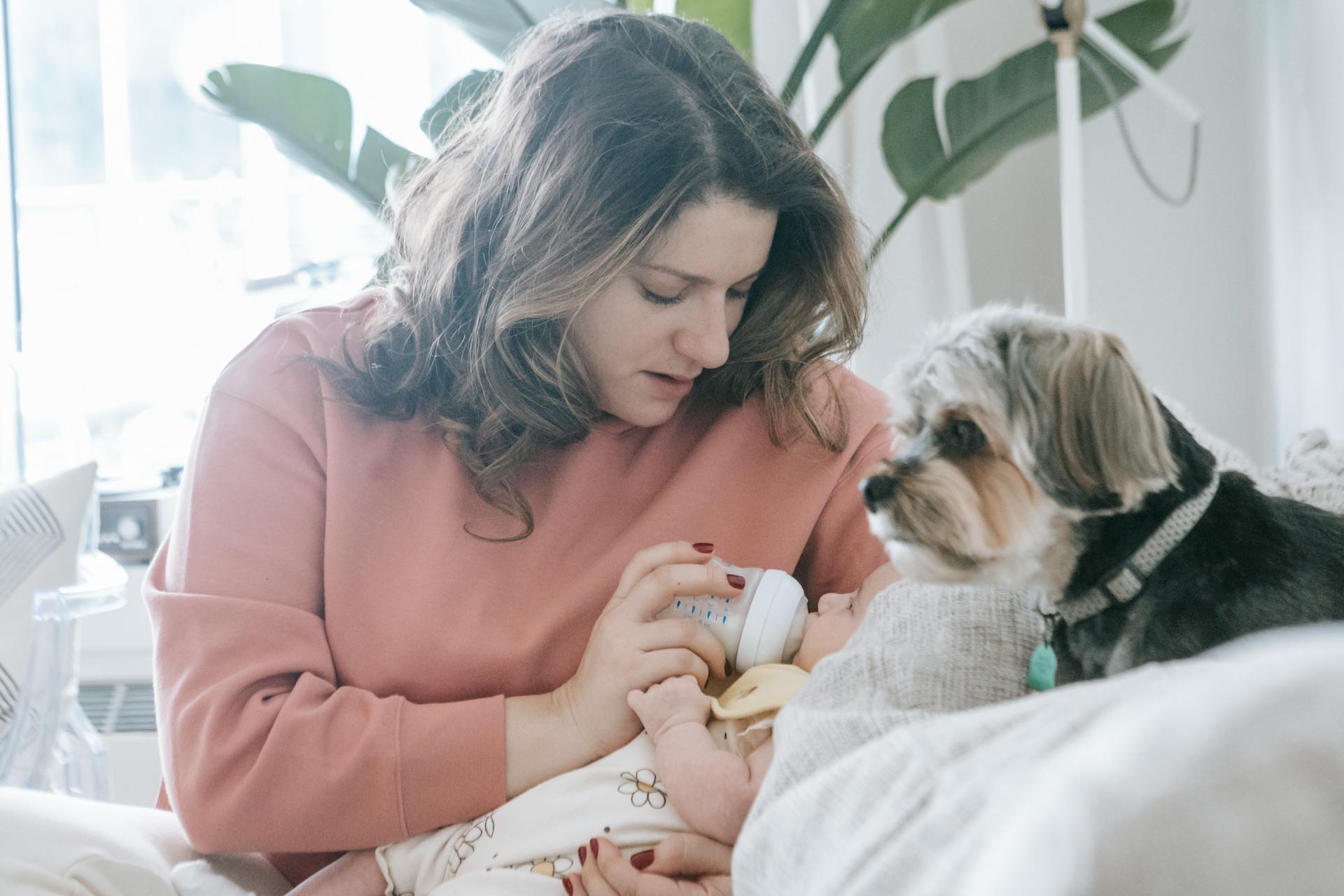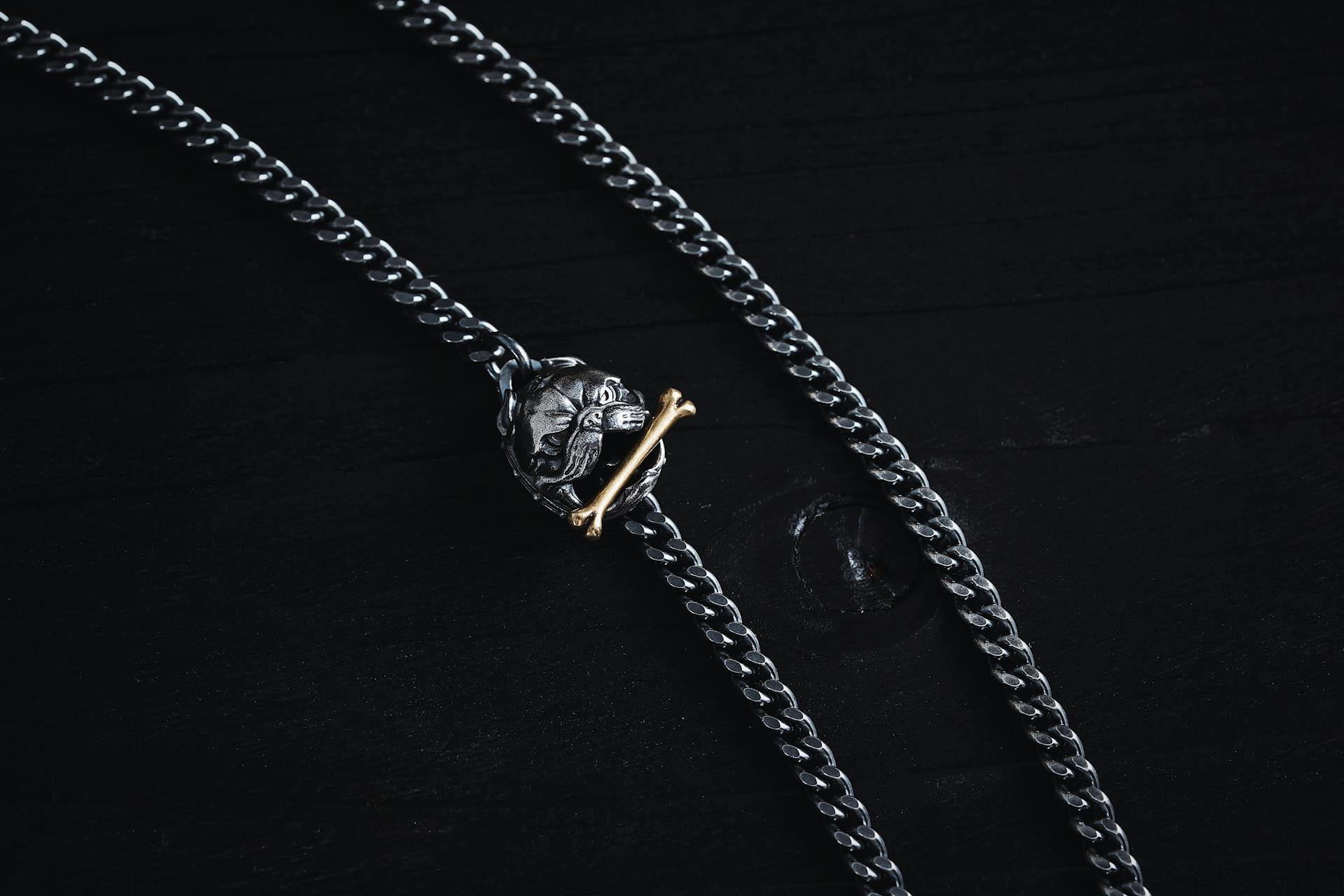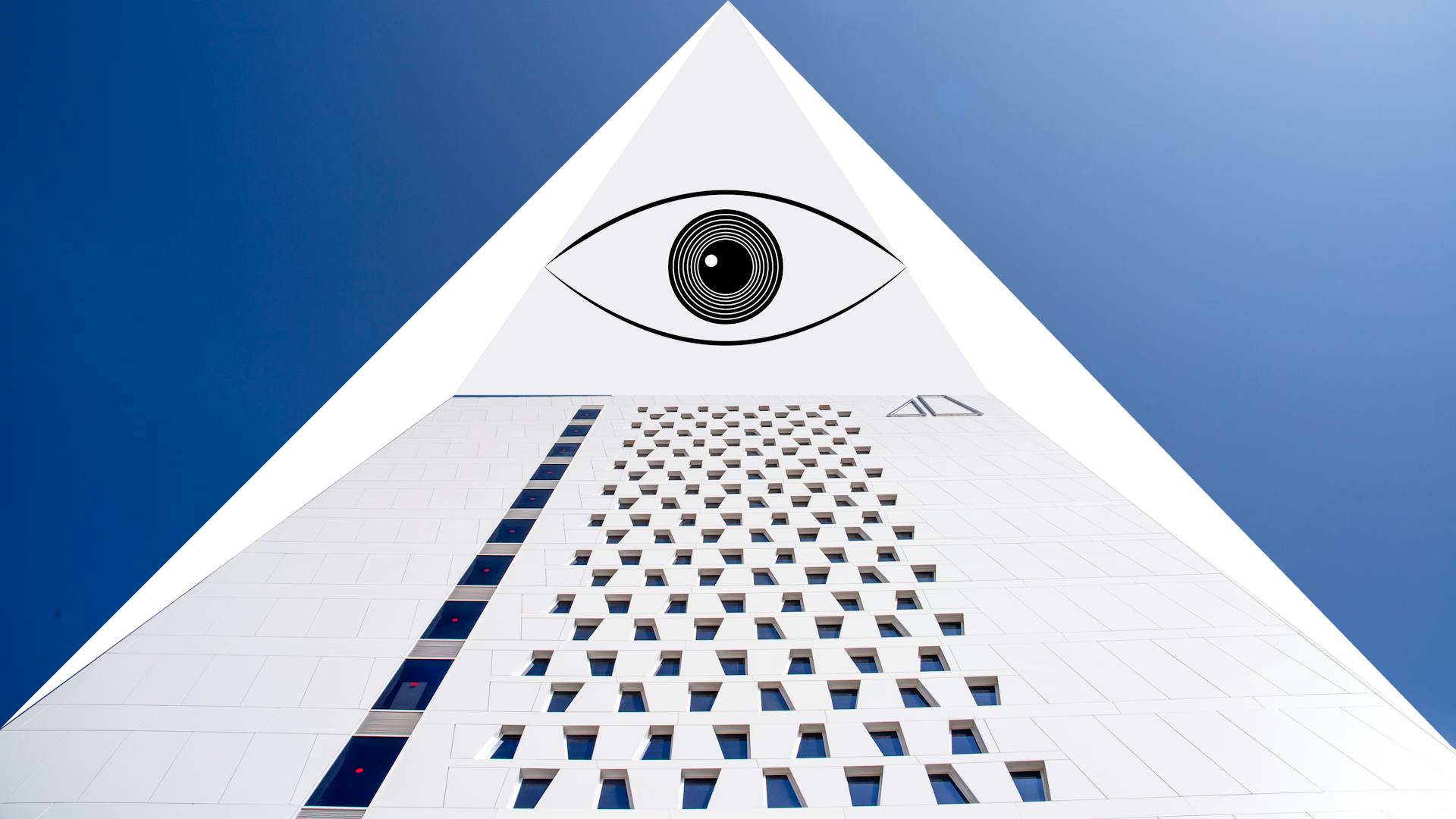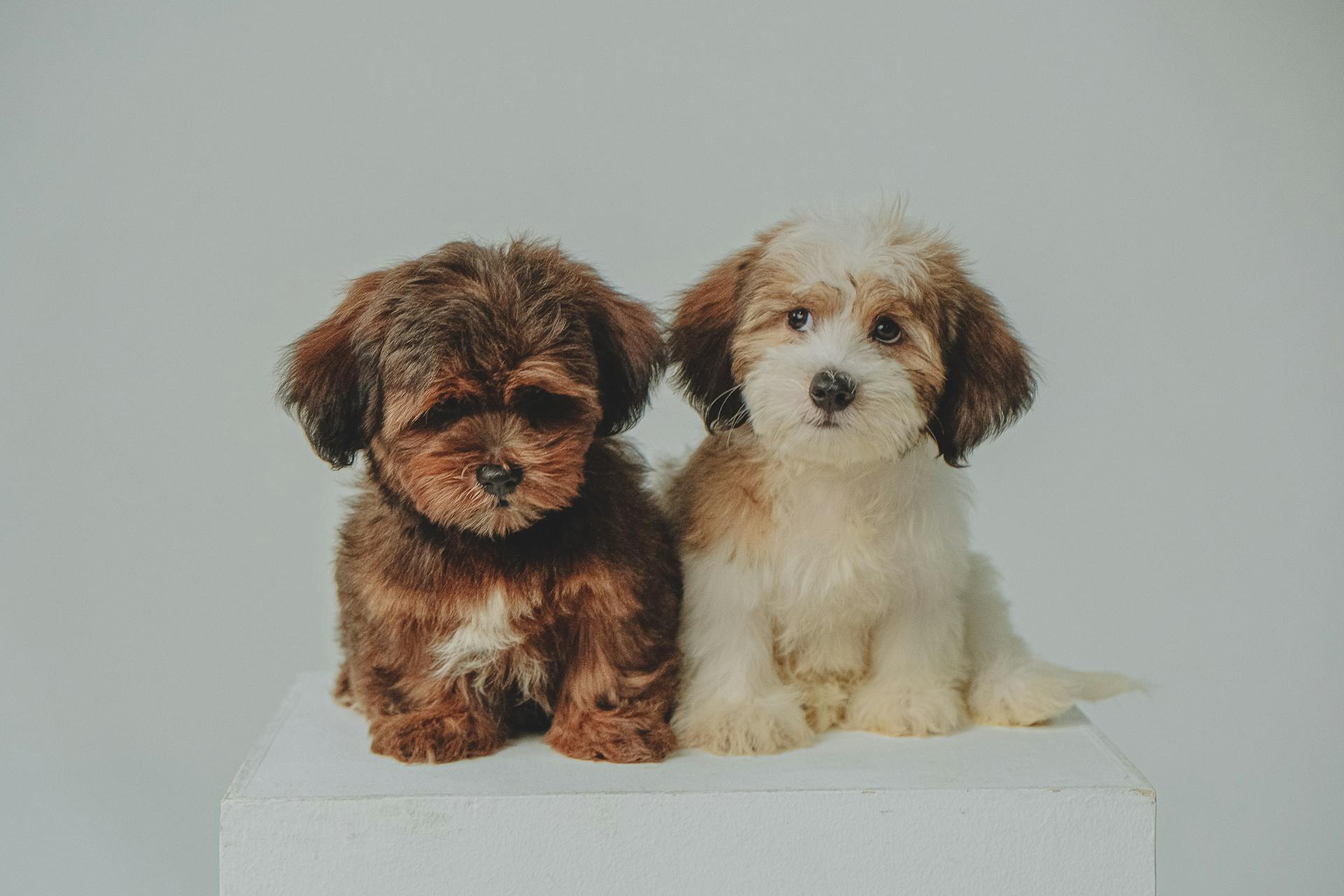
The Havanese dog breed is a small but mighty companion that originated in Cuba and has since become a beloved pet around the world.
They typically weigh between 7-13 pounds and stand at about 9-11 inches tall, making them a great fit for apartment living or families with smaller children.
One of their most distinctive features is their silky, double coat that requires regular grooming to prevent matting and tangling.
Physical Characteristics
The Havanese is a small dog breed that stands between 8.5 and 11.5 inches tall at the shoulders.
Their weight can vary significantly, ranging from 7 to 13 pounds, making them a compact companion.
A full-grown Havanese typically has a rounded face with floppy ears, giving them an adorable appearance.
The ideal height of a Havanese is around 9 to 10.5 inches tall, as per kennel club standards.
Their bodies are slightly longer than they are tall, which can give them a stretched-out look.
One of the unique features of the Havanese is its straight but not completely level topline, which rises from the shoulders to the hindquarters.
The muzzle of the Havanese is full and tapers a bit at the nose, without looking too short or pointy.
Their coat can come in over 20 different known colors and coat patterns, ranging from black to gray, silver, cream, red, and white.
Personality and Temperament
The Havanese is a gentle and affectionate breed that thrives on human companionship.
They're intelligent too, which means they'll enjoy making you laugh with their goofy antics or simply sitting on your lap watching the world go by. This breed is not suitable for people who have to leave their dogs alone for long periods of time, as they can get very anxious when left behind.
A Havanese puppy's temperament is affected by factors like heredity, training, and socialization - so it's essential to choose a puppy with a nice temperament. You should meet at least one of the parents, usually the mother, to ensure they have a good personality that you're comfortable with.
Socialization is key for Havanese puppies, which means exposing them to various people, sights, sounds, and experiences when they're young. This will help your puppy grow up to be a well-rounded dog.
Expand your knowledge: Havanese Breed Standard
Care and Feeding
The Havanese is a small breed with a big personality, and when it comes to caring for them, they require regular exercise to stay happy. A lengthy walk or active game of fetch each day will keep him in top shape.
You'll need to feed your Havanese high-quality dry food, divided into two meals a day, with the recommended daily amount ranging from 1/2 to 1 cup depending on his size, age, and activity level. The quality of dog food makes a difference too - better food will go further in nourishing him.
Crate training is essential for Havanese puppies as they can be prone to separation anxiety; it's also crucial to avoid leaving them alone for long periods of time to prevent this issue altogether.
Related reading: How Much Food Should a Havanese Eat per Day
Diet and Nutrition
A Havanese's diet is a delicate balance between giving them enough nutrients and not overfeeding them.
You should feed your adult Havanese 1/2 to 1 cup of high-quality dry food per day, divided into two meals.
Dogs are individuals, just like people, so the amount of food they need can vary greatly depending on their size, age, build, metabolism, and activity level.
For more insights, see: Havanese Food
Grooming
The Havanese breed requires regular grooming to prevent tangles and mats.
Their double coat is made up of a soft undercoat and a heavier outer coat with an unrefined silky texture that needs daily brushing to keep it free from tangles.
Using a pin comb, slicker brush, or pin brush will help you achieve the best results for your Havanese's grooming needs. A de-matting spray-on conditioner can also be helpful in breaking down tangles.
The frequency of brushing depends on how long you allow their coat to grow - if left untrimmed, it should be brushed at least 3-4 days a week. Short-haired Havanese, however, don't require as much weekly upkeep as long as their haircuts are scheduled regularly.
Bathing is necessary only when the coat gets dirty, and care should be taken not to over wash their delicate fur. Practicing basic grooming with your puppy will help them learn that it's a positive and relaxing experience.
Explore further: Best Brush for Havanese
Grooming and Maintenance
The Havanese coat is thick but silky, soft, and light, and it doesn’t shed easily.
To keep your Havanese looking its best, you'll need to brush its coat daily when kept long, as mats can form quickly. You might also consider clipping the coat short to make grooming easier.
Regular nail trimming is essential - trim them once or twice a month if your dog doesn't wear them down naturally, as long nails can click on the floor and scratch your legs.
As for teeth brushing, aim to do it at least two or three times a week, with daily brushing even better for preventing gum disease and bad breath. Brushing your Havanese's teeth regularly will also help remove tartar buildup.
Daily cleaning of the corners of the eyes is recommended to prevent tear stains - you can use a damp cloth for this. You might also consider using whitening products on the market specifically designed for lightening eye stains.
Ear cleaning is crucial, especially to remove excess moisture, wax, or debris from the ear canals and reduce the risk of infection. Introduce your Havanese to these rituals as early as possible to make grooming a positive experience filled with praise and rewards.
Related reading: Grooming Havanese
Training and Behavior
Havanese are highly trainable extroverts that thrive on positive reinforcement and attention from their humans.
They do best with patience and consistent training, especially when it comes to housebreaking, which can take longer than other breeds due to their sensitive nature.
Socialization is key for Havanese puppies to avoid developing anxiety towards other pets, children, or strangers. Early socialization can make a big difference in their behavior as adults.
With consistency and patience, Havanese puppies can learn to hold it and become well-behaved companions.
A different take: Havanese Mix Puppies
Health and Risks
The Havanese breed is not immune to health problems, and some conditions may be more likely to affect them.
Chondrodysplasia, also known as osteochondrodysplasia, is a genetic condition that can cause skeletal dwarfism, slowing down bone and cartilage growth, and potentially leading to deformities, pain, and arthritis later in life.
A vet's proposed solutions for chondrodysplasia may include medication to help with the dog's pain or the prescription of progestin, which has shown effectiveness in some cases.
Chondrodysplasia
Chondrodysplasia is a genetic condition that slows the growth of bones and cartilage.
This condition can lead to skeletal dwarfism, causing deformities in a dog and potentially leading to pain and arthritis later in life.
Havanese dogs are particularly vulnerable to chondrodysplasia.
Risks
No dog is totally immune to health problems, unfortunately, and the Havanese is no exception.
The Havanese may be slightly more likely to affect by certain conditions. No specific details are provided about these conditions, but it's worth noting that they can still occur in this breed.
Unfortunately, some health risks do come with owning a Havanese dog. They include a few conditions that may be slightly more likely to affect this breed.
Take a look at this: Havanese Dogs Short Hair
Socialization and Interactions
The Havanese is an excellent family dog who's affectionate with everyone, including kids of all ages and other dogs and pets.
Proper socialization and training are imperative for a Havanese to get along well with children and other pets. This includes teaching your child how to approach and touch the dog, and supervising any interactions between dogs and young children to prevent biting or ear or tail pulling on either party.
A Havanese can be quite sturdy despite being a smaller breed, but it's essential to teach kids not to approach the dog while he's eating or sleeping, or try to take the dog's food away. This will help prevent any accidents or conflicts between your child and the dog.
Havanese dogs may develop separation anxiety if left alone for too long, so they do best in homes where someone is always by their side. This means that you'll need to plan your day around giving your Havanese plenty of attention and interaction.
Early socialization with new sights, sounds, people, dogs, and other animals as a young puppy is crucial for a Havanese's socialization and sets them up for a lifetime of fun adventures. This includes introducing the dog to children and other pets in a controlled environment to help them acclimate.
In addition to early socialization, it's also essential to teach your child how to respect the dog's personal space and boundaries. This means giving the dog its own "safe space" where they can go when they need some quiet time.
Rescue and Adoption
Many Havanese are purchased without a clear understanding of what owning one entails, leading to a need for adoption and fostering.
There are numerous rescues that can help facilitate this process, such as the Havanese Club of America Placement and Rescue Service Committee.
If you're unable to find a rescue in your area, contacting the national breed club or a local breed club can provide guidance on where to turn.
For your interest: Havanese Rescue California
Rescue Groups
There are many wonderful Havanese rescue groups dedicated to finding forever homes for these lovely dogs.
The Havanese Club of America Placement and Rescue Service Committee is one such organization that can help you find a rescue group in your area if you're interested in adopting a Havanese.
If you don't see a rescue listed for your area, contacting the national breed club or a local breed club will point you toward a Havanese rescue.
Related reading: Havanese Rescue Dogs in Florida
Organizations
If you're considering adopting a Havanese dog, there are several reputable organizations that can guide you through the process.
The Havanese Club of America is one such organization that promotes the welfare and well-being of the breed.
Here are some key points to keep in mind when searching for a responsible breeder:
- Reputable breeders prioritize breeding healthy, well-socialized puppies.
This means they take the time to screen their breeding stock for health problems and socialize their puppies from a young age.
Frequently Asked Questions
What are the disadvantages of Havanese?
Havanese dogs require regular grooming and may experience separation anxiety if left alone for extended periods
What two breeds make a Havanese?
A Havanese is a cross between the Blanquito and other bichon types, including the poodle.
How big is a Havanese full grown?
A Havanese full grown typically weighs 7-13 pounds and stands 8.5-11.5 inches tall at the shoulder. They reach their full size around 6-8 months old.
Can a Havanese weigh 20 pounds?
Yes, a Havanese can weigh up to 20 pounds or more. However, their average weight typically ranges from 8-13 pounds.
Is a Havanese a good family dog?
Yes, Havanese dogs are wonderful family pets, but they thrive in homes with constant human companionship. Early socialization and training are also essential for their well-being.
Featured Images: pexels.com


